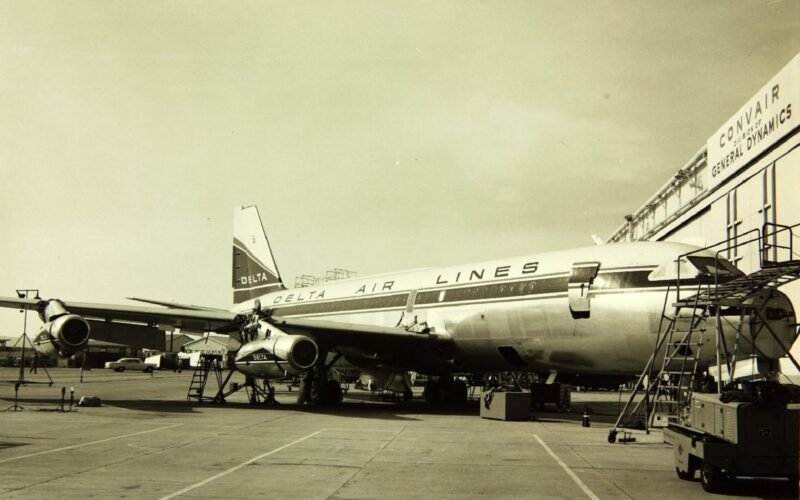Ninety-seven years ago today, Delta Air Lines was founded in the city of Macon, Georgia. What began as a small crop-dusting operation has become a United States legacy airline and one of the largest airlines in the world with a fleet of 850 aircraft. The name Delta comes from the Mississippi Delta region it served originally.
History
Huff Daland Dusters was established on March 2, 1925 and was the world’s first aerial crop-dusting company. This agricultural venture was the culmination of military and private investment to improve crops which, at the time, were being devastated by pests, posing a serious threat to the cotton industry and wider economy.
Huff Daland & Co began building a plane capable of crop dusting and, in September 1924, the first dusting for insect control took place with the Huff Daland Duster spraying 1,800 acres in Mississippi. The business grew and, by the end of March 1925, Huff Daland Dusters had a fleet of 18 privately-owned aircraft. Within months, contracts were signed for dusting in Alabama, Georgia, Louisiana, Mississippi and North Carolina.
In June 1928, Collett Everman Woolman, principal founder of Huff Daland Dusters, led a consortium of investors to buy the company and so the name was changed to Delta Air Service. Starting with air mail, Delta soon expanded to operate its first passenger service in 1929 from Dallas to Jackson.
Delta moved its headquarters to Atlanta, and, throughout the Second World War, it contributed to the war effort by modifying aircraft and training pilots as well as mechanics. By the end of the war, the name had changed to Delta Air Lines, Inc.
The jet age
Throughout the 1950s and 1960s, Delta expanded hugely using the hub and spoke concept, flying its first international routes to the Caribbean as well as becoming the first airline to fly the Douglas DC-8 and Convair 880 jet aircraft in 1959 and 1960 respectively.
In 1966, Woolman died. During his life, he was known for his caring attitude towards Delta employees. It is said that he was saddened when the company grew so much because he could no longer remember each employee by name.
Meanwhile, the iconic Boeing 747-100 entered service with Delta in 1970. But it was short-lived. The type was returned to Boeing from 1974 onwards, cited as being too big for Delta’s operations. However, the Boeing 747 returned to Delta following the merger with Northwest Airlines in 2008. In 1978, Delta began transatlantic services to London soon followed by Frankfurt.
The Spirit of Delta
Following the economic downturn in the early 1980s, Delta suffered huge financial losses. But in a testament to the employees’ affection for the Delta brand, more than 7,000 workers and relatives raised $30 million through payroll deductions and donations to purchase the first Boeing 767, aptly named The Spirit of Delta. The aircraft remained in the fleet until 2006 and is now on display at the Delta Museum in Georgia.
With the bankruptcy of Pan Am in 1991, Delta acquired all of Pan Am’s transatlantic routes and soon began significant expansion through increased routes and schedules. In 1997, the airline achieved the impressive milestone of carrying 100 million passengers in a single year.
Entering the new millennium, Delta partnered with Aeroméxico, Air France and Korean Air to found the SkyTeam alliance which today is one of the largest alliances in the industry with 26 members serving 195 countries with 19,000 daily flights. Throughout the early 2000s, Delta replaced older aircraft such as the Boeing 727 and MD-11 with Boeing 767, 737 and 777 aircraft.
However, as early as 2004, Delta began the process of restructuring in order to avoid bankruptcy including adding to its services from Atlanta and cutting many jobs. Despite its efforts, it filed for bankruptcy in 2005, and the company managed to fight off a takeover bid from rival US Airways.
The airline’s fortunes soon turned around and, by 2007, Delta had returned to profitability, re-listed on the stock exchange and showcased a new livery and logo. A year later, Delta and Northwest Airlines merged to create the world’s largest airline, a status the new company enjoyed until the American Airlines (A1G) (AAL) and US Airways merger in 2013. Following the Northwest merger, the Delta branding remained in place.
Through the next decade Delta published record profits and committed to upgrades for passenger experience including all new lie-flat beds and increased first class cabin availability. The airline also acquired a 49% stake in the UK airline Virgin Atlantic, allowing access to important trans-Atlantic markets.
With the onset of the COVID-19 pandemic, more than 550 aircraft were parked in long-term storage and the airline turned to cargo-only flights, stripping out passenger seats from the main deck of aircraft to fly essential medical equipment, including COVID-19 vaccines, between the US, Europe and Asia. In order to reduce costs, Delta retired the ageing McDonnell Douglas MD-88, MD-90 and Boeing 777 aircraft from its fleet.
Looking ahead
Today, Delta operates a mix of Boeing and Airbus aircraft including the international flagship A350-900 as well as the A330-900neo, A220 and Boeing 737-900ER. It is currently the largest operator of the A220, Boeing 717 and Boeing 757 aircraft.
Operating mainly out of Atlanta, Boston and Detroit, the carrier flies to an impressive 325 destinations in more than 50 countries. As Delta approaches its centenary year, the challenge for the company and its 75,000 employees will be the emergence from a COVID-19 world, a return to pre-pandemic performance, and reaching new heights.
In the words of Delta’s founder C.E. Woolman: “I’m optimistic about the future of air transportation. This industry grew up on problems—and it grew because it solved them.”

